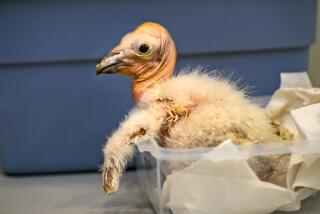‘Crane mania’ packs tourists into quiet town : 20,000 of the birds stage dancing, courting rituals. Visitors to Colorado valley and the natives love it.
MONTE VISTA, Colo. — Even before their yellow bus lumbered to a stop on a rural road skirting a frozen marsh in this Rocky Mountain valley, dozens of impatient passengers were wiping the frosty windows for a view of one of nature’s most ancient rituals.
Standing like sentries in the early morning light were some of the 20,000, 4 1/2-foot-tall sandhill cranes that have been coming to the San Luis Valley each March for millennia to court and dance with their lifelong mates.
“Ooh! Look at them all!” said Denver high school teacher Elizabeth Krieder, peering through her binoculars at the flock of cranes waking from their roost. “This is one of the major treats of my life.”
Denver writer Sharon Harris smiled and nodded. “These are genuine bird brains--and that’s a compliment.”
They are also a boon to this tiny potato-growing community, which is cashing in on the “eco-tourism industry” that is drawing record crowds to national parks and making cash cows out of such annual natural spectacles as whale migrations off the coast of California.
For the past decade, the folks of Monte Vista have turned the arrival of the long-necked gray birds into an all-out “Wild Wingwatch” celebration that draws 4,000 visitors from as far away as Japan, where cranes are revered as symbols of marital fidelity and longevity.
For residents of Monte Vista, the 10-day festival that ended Sunday is a chance to introduce city slickers to the benefits of preserving unspoiled natural vistas and the rural life--and to promote potatoes, still the lifeblood of this farming community of 4,600 people. The average annual per capita income here is less than $10,000.
“Crane mania” hits town after the fall harvest, when volunteers begin laying the groundwork for bus tours to the mating grounds, bluegrass music concerts, pre-dawn pancake breakfasts and banquets served by the light of antique oil lamps.
“The phone never stops ringing, and you never have a meal on the table before nine o’clock,” said Sharon Bowles, the festival’s arts-and-crafts coordinator.
Donna Kingery, chairwoman of the Monte Vista Crane Festival Committee, figures that festival-goers will have spent tens of thousands of dollars in local restaurants, hotels and other businesses.
“That doesn’t sound like very much, but here during the spring it’s quite a bit,” said Kingery, whose full-time crane-season duties include dashing off press releases, cutting and folding crane centerpieces and finding a keynote speaker for the town’s big Crane Banquet.
Kingery’s mother, Ruth Bruns, pitches in by running press releases to the post office--and buying stamps when crane committee funds run low. Her husband and son help set up booths for arts-and-crafts displays.
Dorothy Dean, 32, who drives a tour bus donated by the Monte Vista Headstart program, is liable to surprise her passengers with a detour down country lanes leading to other nature experiences, such as a pair of long-horned owls that have built their nest in an elm tree three miles outside of town.
The San Luis Valley Women’s Potato Auxiliary serves up a “home-grown potato luncheon” of potato casserole, potato biscuits, potato salad and even potato brownies. Included with the $7 lunch is a potato cookbook, fact book, bookmark and refrigerator magnet.
Oblivious to the town’s endeavors on their behalf, courting sandhill cranes do what comes naturally: hopping into the air, flapping their wings and throwing back their heads--sometimes standing on one foot.
Lucky visitors may also catch sight of five whooping cranes in the sandhill flock. Unlike the numerous sandhill cranes, only 155 whooping cranes exist in the wild.
Where the flock now feasts on potatoes and grains among herds of elk and deer, their ancestors 60 million years ago dodged dinosaurs to forage on now long-extinct plants.
Modern times have brought human beings to the scene in growing numbers.
Kingery says she thinks that the festival could easily quadruple in size if it were spread out over more days.
But she and others point out that visitors are already hard-pressed to find an available hotel room during the festival.
Beyond that, “we don’t want so many people here that the birds are loved to death,” Kingery said.
But Rick Schnaderbeck, assistant manager of the Monte Vista and Alamosa National Wildlife Refuges and a festival tour guide, views the crowds as a plus--provided that they keep their distance.
“The more people who experience the beauty of the cranes and the value of the wetlands,” Schnaderbeck said, “the more people you’ll have who will help you protect them.”
More to Read
Sign up for The Wild
We’ll help you find the best places to hike, bike and run, as well as the perfect silent spots for meditation and yoga.
You may occasionally receive promotional content from the Los Angeles Times.






